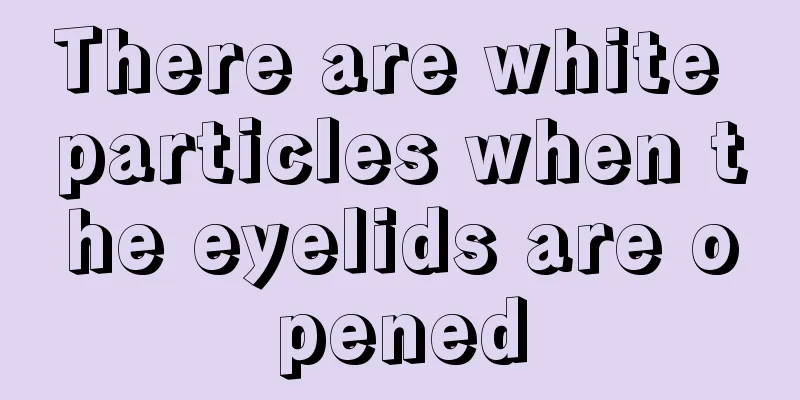There are white particles when the eyelids are opened

|
Friends who often wear cosmetic contact lenses or cosmetic contact lenses will see a lot of white particles inside the upper eyelid when they turn over their eyelids. These particles do not cause any pain or itchiness, and do not affect our eyesight. What exactly are they? In fact, these white particles are eye stones. Most of the time it is caused by inflammation of the cornea. Most eye stones do not have much impact on patients, but everyone still needs to do a good job of prevention and care. Eye stones are multiple hard yellow spots on the conjunctiva of the face. They are the degeneration products of epithelial cell accumulation and mucus concentration and pressure. They never calcify and are actually conjunctival agglomerates, so the term stone is inappropriate. When this object is located deep in the cornea, there will be no discomfort. However, when it protrudes from the conjunctival surface, it will irritate the cornea and produce a foreign body sensation, or even cause corneal abrasion and erosion. Under surface anesthesia, it is removed with a sharp knife or foreign body needle. This disease is more common in adults, the elderly, and patients with trachoma and chronic conjunctivitis. Indeed, "stones" often grow on the conjunctiva of the eye, which is called conjunctival calculi in medicine. Conjunctival stones are coagulation products of desquamated epithelial cells and degenerative cells accumulated in conjunctival epithelial depressions or deep tubular crypts. They have no or very little calcium deposits and are not true stones. Conjunctival stones are more common in adults, mainly in patients with chronic eye diseases such as trachoma and chronic conjunctivitis. They often appear on the upper eyelid. There are hard, yellow-white, small dot-like protrusions on the conjunctiva, shaped like broken rice. Some are scattered in dots, and some are densely packed in groups. At first, the stone is located deep and buried under the conjunctiva. Generally, there are no subjective symptoms. Later, it gradually emerges on the surface of the conjunctiva. Only when the nodule protrudes from the surface of the conjunctiva will there be a foreign body sensation, and it may even cause corneal abrasion. In this case, it can be removed with a knife tip or injection needle under surface anesthesia. If there are no irritation symptoms, no treatment is required. If it is complicated by trachoma, chronic conjunctivitis and other diseases, the primary disease should be treated after provocation. However, most patients may continue to grow new stones after the stones are removed, and often require regular treatment to prevent corneal abrasion. According to traditional Chinese medicine, intraocular stones are caused by wind evil invading the spleen meridian, blocking the eyelids, and turning into heat over time, burning body fluids and causing stagnation in the eyelids. They can be treated with agents that clear the heart and spleen and heat, such as Neishu Huanglian Decoction with modifications. In fact, although they are called stones, eye stones are different from true stones such as kidney stones and gallbladder stones. Some people get nervous when they hear that they have eye stones, thinking it is a serious illness and requires surgery. In fact, eye stones are just minor eye problems. There is no or very little calcium deposits, so they are not real stones. In order to reduce people's panic about eye stones, the medical community once wanted to rename it "conjunctival agglutination", but most people still call it eye stones according to traditional habits. When the eye stones are just small particles buried under the conjunctiva and do not protrude beyond the surface of the conjunctiva, the patient himself will not feel the existence of the stones and can ignore it for the time being. Once it "pops" out, it will irritate the eyelid and even scratch the cornea, making people feel like there is a foreign object in the eye and causing stinging. You can go to the hospital to have it removed. Picking out eye stones is just a minor operation and can be done in the outpatient clinic without the need for hospitalization. The operation is very simple. First, apply eye drops for surface anesthesia, clean the patient's eyes, and then use a needle to pick out the conjunctival mass. However, some patients may continue to grow new stones after the stones are removed, such as Zhang Jiezhi. Because eye stones are often caused by eye inflammation, if the inflammation is not eliminated, you will only remove the stones symptomatically. The cause of the disease will not be eliminated and the stone may recur next time, just like acne on your face. If eye stones grow again and symptoms occur, continued treatment is needed to prevent corneal abrasion. Although regular removal of eye stones does not cause blindness, it is extremely troublesome. Therefore, if patients want to cure the disease, they must find out the real cause. For example, Zhang Jiezhi first needs to confirm whether his stones are caused by chronic keratitis, and then treat the inflammation. Once the inflammation disappears, eye stones will no longer exist. Keep your eyes moist and prevent foreign objects from entering your eyes. Since most eye stones are caused by inflammation, preventive measures should focus on preventing eye inflammation, with an emphasis on preventing irritation and inflammation of the conjunctiva. Seek medical treatment promptly if you have eye discomfort. Develop healthy eye hygiene habits, do not rub your eyes, keep your eyes moist, and prepare eye drops to use at any time to prevent foreign matter from entering your eyes. Contact lens wearers should pay attention to the disinfection and maintenance of the lenses and check their eyes regularly. If you are not suitable for wearing contact lenses, do not force yourself to try. People who work outdoors or live in an environment susceptible to sandstorms should wear protective glasses to prevent sand from blowing directly into their eyes. Although eye stones are only small lesions of the conjunctiva, they are a "danger signal" that reminds you to pay attention to the health of your conjunctiva. |
<<: What's wrong with my eyelids peeling
>>: Neurodermatitis on the eyelids
Recommend
Is bloodletting and cupping harmful to the body?
Bloodletting and cupping is also a form of cuppin...
Breathe in the cool air through your nose
Feeling cool when breathing into your nose is a t...
During cardiopulmonary resuscitation, the sternum should drop at least
The heart is one of the important organs of the h...
People need to pay attention to the prevention of lymphoma
Nowadays, more and more people may suffer from ly...
What to do if corn patch hurts
When people get corns, they think that it is not ...
The efficacy of hawthorn and tuckahoe tea
Hawthorn and Poria cocos tea is made from hawthor...
Can massage make your nose smaller?
Nowadays, people pay more and more attention to t...
What is the cause of the lump above the incision after thyroid cancer surgery
The appearance of a lump above the incision of th...
How long can cooked meat be frozen?
Meat is rich in protein and nutrients and is an i...
Some solutions to cold hands and feet
Some friends will have cold hands and feet when t...
Who is prone to prostate cancer? Prostate cancer favors these 4 types of men
Prostate cancer is a common disease in clinical m...
Anti-inflammatory drugs that do not stimulate appetite
The main function of anti-inflammatory drugs is t...
Several methods for diagnosing bladder tumors
Many patients discover bladder tumors relatively ...
My leg is scratched, how can I get better quickly
Although abrasions are not considered serious inj...
The harm of using a hair dryer to blow dry your hair
Many friends are used to using a hair dryer to dr...









